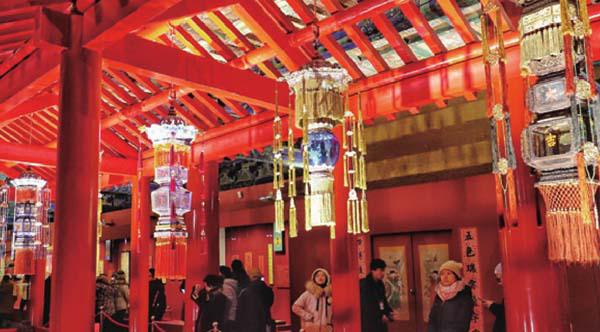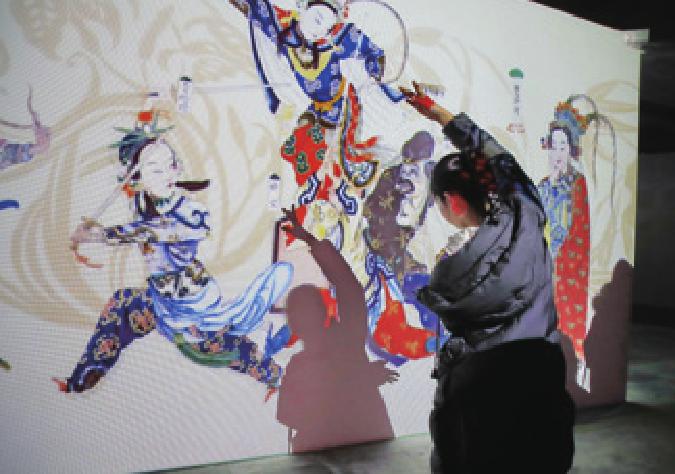Imperial Celebrations
By Ji Jing

How did ancient emperors celebrate the Spring Festival? An ongoing exhibition at the Forbidden City may provide a clue. The Beijing landmark, which houses the Palace Museum, was the former Chinese imperial palace for the Ming (1368-1644) and Qing (1644-1911) dynasties.
The exhibition, titled Celebrating the Chinese Lunar New Year and Ushering in Auspiciousness, is being held from January 8 to April 7 on the second fl oor of the Forbidden Citys Meridian Gate (Wumen). A total of 885 artifacts are on display, the largest number of antiques showcased in one exhibition in the Palace Museum since 1993.
“We want to show more antiques regarding the Spring Festival customs to audiences… We welcome them to celebrate the Lunar New Year in the Forbidden City,” Shan Jixiang, President of the Palace Museum, told the media.
A cavern of delights
The exhibition consists of six sections. Objects used for Spring Festival celebrations in the palace are displayed in the fi rst section, including Spring Festival couplets, poetic calligraphy written on red paper pasted on the left, right and top of house doors expressing peoples good wishes for the Lunar New Year, and pictures of door-gods, which used to be pasted on doors to drive away evil spirits and protect the house.
Calligraphy of the Chinese character Fu, which symbolizes good fortune and luck, written by emperors Kangxi, Yongzheng, Qianlong, Jiaqing and Daoguang of the Qing Dynasty, are also exhibited. The artifacts displayed in this section refer to wishes of good luck in the Lunar New Year.
The second section displays objects used as offerings to ancestors, which is an important activity for Chinese people during the Spring Festival. In addition to ancestors, an offering is also held at the Palace of Earthly Tranquility(Kunning Gong) on the 23rd day of the 12th lunar month to pay tribute to the Kitchen God who guards family stoves along with the entire family.
The third section is devoted to feasts between the emperor, his empress and concubines and the emperors relatives on the f irst day of the Lunar New Year. Like today, reunion dinners of the royal family were an indispensable part of the Spring Festival for ancient rulers. The section replicates scenes of the feasts, including the table and dishes, according to records from 1783, the 48th year of Emperor Qianlongs reign.
Along with ordinary people, Qing Dynasty emperors also ate dumplings for their fi rst meal of the Lunar New Year. A eunuch would send the emperor dumplings in an exquisitely carved lacquer box which was put on display. Carved lacquer is a distinctive Chinese form of decorated lacquerware.
The fourth section replicates a ceremony held at the Hall of Mental Cultivation(Yangxin Dian) at the beginning of the New Year to mark the start of work for the emperor. He would write a letter of best wishes for all his people and put it in a box, which no one was allowed to see. The emperor was not supposed to work during the Spring Festival, although he would have to deal with state affairs if needed.
Instruments from the royal symphony orchestra during the Ming and Qing dynasties are also displayed in this section. As ministers saluted the emperor in the Hall of Supreme Ha rmony (Taihedian) and family members saluted him at the Palace of Heavenly Purity (Qianqing Gong), the orchestra would play music to accompany the ceremony.
The fifth section shows entertainment activities held in the Forbidden City during the Spring Festival, as the emperor would take the opportunity to relax and have fun. A picture drawn by Zhang Weibang and Yao Wenhan, court painters during Qianlongs rule, shows artists performing acrobatics and ice skating on the eighth day of the 12th lunar month.
Opera was also an important form of entertainment for the royal family during the Spring Festival. Eight delicate costumes are showcased.
“The Spring Festival is a time for reunion. Its also Chinese peoples carnival. Ancient emperors took part in all kinds of entertainment activities like ordinary people,” Ren Wanping, Vice President of the Palace Museum, told the media.
The sixth section consists of over 1,000 replicas of Spring Festival couplets and lanterns that light up the entire Forbidden City and add to the festive mood.
“Palace gates in the Forbidden City are all decorated with Spring Festival couplets and paintings, and lanterns are hung in corridors. When audiences come to the Forbidden City, they will be able to experience a joyous festival atmosphere,” Ren added.
More treats
In addition to the exhibition at Wumen, a digital exhibit, providing audiences with immersive experiences of the Spring Festival in the Forbidden City, opened at Qianqing Gong on January 23.
Digital projection and virtual reality technologies are employed. In one interactive scene, if someone opens their arms, they will be showered with digital calligraphy of the character fu, letters of blessings written by ancient emperors, and flowers and fruits that have fortuitous connotations.
The Palace Museum has also developed nearly 100 cultural and creative products featuring Spring Festival themes. Products such as silk scarves, teaware and cushions were developed incorporating elements like playing on ice, doorgods and plum blossoms.
Moreover, 145 time-honored brands from 10 provinces and municipalities are invited to hold an exhibition in the Forbidden City from January 28 to February 10, to showcase traditional delicacies, clothing and handicrafts to enrich the audiences understanding of the Spring Festival.

